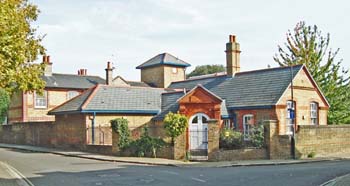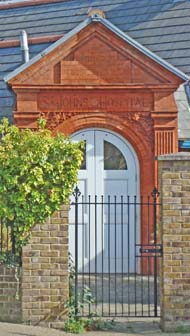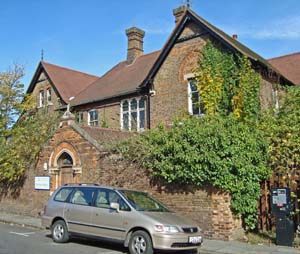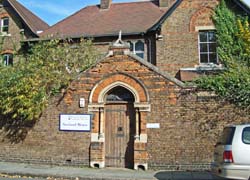St
John's Hospital
Amyand Park Road, Twickenham, Middlesex
TW1 3HG
Medical
dates:
Medical
character:
Mainly acute (G.P.)
In 1879 the philanthropist Miss Elizabeth
Twining (1805-1889), of Dial
House,
Twickenham, purchased Amyand
House and its grounds for £3,000. She wished to
establish a hospital in memory of
her family, who had been associated with the area for seven generations.
A Trust Deed was drawn up on 5th March 1879, nominating Edmund Holberton (a relative by marriage) and two of her nephews - Herbert Haynes Twining and Samuel Twining - as trustees. It stated that "the institution shall be known as the Twining Hospital and shall be dedicated to St John the Baptist" and would contain an Out-Patients Department, male and female wards, rooms for nurses and a house for the Resident Medical Superintendent.
Miss Twining provided funds for the hospital to be built, also giving an endowment of £3,000. The stables were demolished and the hospital built on their site. Miss Twining had devoted the greater part of her life to the poor and, towards its close, gave almost the whole of her resources to the founding and erection of this hospital, which was built with the best materials and workmanship.
St John's Hospital was officially opened on 25th May 1880 by the Duchess of Teck accompanied by three of her children - Princess Victoria Mary (later Queen Mary) and Princes Adolphus and Francis Joseph. The Duke of Teck arrived later on horseback.
The Hospital consisted of an Out-Patients Department and dispensary, which had opened on 19th April 1879, and two small wards of 6 beds each - one for men and one for women - which, due to bad weather, had not been quite completed by the opening date (in fact, they were not opened for in-patients until 7th September 1880.
Amyand House, a 2-storey building which had been built in 1760, became the residence for Dr Benthall, previously of King Street, Twickenham, who had been appointed the Medical Superintendent. Other members of the medical staff, including eminent London consultants, acted in an honorary capacity (that is, they were not paid).
In August 1879 a phenomenally violent hailstorm broke 30 to 40 panes of glass in the skylights and windows of Amyand House.
As a Provident hospital, it was intended to benefit local working men and women whose income came within certain prescribed limits (both the rich and the poor were excluded from the Provident Scheme). In-patients paid a weekly sum of between 2s 6d (£0.12) and 3s 6d (£0.17) and the Out-Patients Department was conducted in accordance with the rules of Provident hospitals. As with other voluntary hospitals, no pregnant women, no child under the age of 6 years, no patients with mental illness, epilepsy, smallpox or other infectious disease, or who had habitual ulcers of the legs, tuberculosis or an incurable condition were admitted.
The early years of the Hospital were dominated by financial crises. The endowment was too small and the person appointed to collect subscriptions was unsatisfactory. The methods of running the Hospital were amateurish and unbusiness-like, to the extent of not allowing any qualified doctors to be on the Committee.
In June 1882, less than two years after they had opened, the wards were closed. They reopened after one month, following the resignations of the Honorary Secretary and 13 members of the Committee and the appointment of a new Secretary and Committee.
The relationship of Dr Benthall with the Committee had also been under stress, as he was not allowed to attend their management meetings, had to provide his own cook, who also had to cater for the in-patients, and having had to pay some £50 personally for the reception of the Duke and Duchess of Teck and 300 guests in Amyand House during the opening ceremony. The situation was further exacerbated by untrue reports of him receiving a massive salary. In fact, Dr Benthall received a small percentage of the Provident payments and was considerably out of pocket. However, the persistent rumours affected his private practice and, when he was given the required three months notice by the new Committee in order to save costs, he took legal action for his reinstatement or, failing that, financial compensation.
As the Hospital rapidly approached bankruptcy, it closed in April 1883 while the Committee applied to the Charity Commissioners for a new scheme not to include the office of a Resident Medical Superintendent under the terms of the Trust Deed.
In the event, Dr Benthall lost his case with costs, and similarly his Appeal. On 28th March 1884 the Charity Commissioners initiated a scheme whereby the office of Resident Medical Superintendent was abolished. Dr Benthall was offered £200 compensation with a requirement that he vacate his residency within 21 days. His Appeal, heard on 25th October, was refused with costs.
The Hospital reopened on 1st June 1885 without a resident Medical Superintendent. The local General Practitioners (G.P.s) took over care of the in-patients and were included as members of the Committee, which now contained practical business-like men. It was decided to abandon the Provident Department as there was already a Provident Dispensary in existence in Twickenham.
Amyand House, no longer needed as a residence for the Medical Superintendent, was rented for £50 a year to a Dr Thomson until 1887, when it was extensively repaired and then let to Dr Marston Clark, Medical Officer of Health for Twickenham.
In January 1932, due to the increasing number of road traffic accidents, the two main wards were extended and re-equipped. The new extensions were opened by the Princess Royal on 8th March 1932. The Hospital had 34 beds.
In 1933 work began on a building for the X-ray Department, which was completed and opened in 1935. Newland House, an adjacent property, was purchased in 1935 to provide an office for the Hospital Secretary and accommodation for the nursing staff (in 1937 the Hospital received an anonymous donation of £1,000 towards the cost of this purchase).
In 1937 the Sterilising Department was enlarged and a new sterilising plant installed at a cost of £349. The X-ray Department was improved at a cost of £64. During August the exterior of the Hospital and Amyand House were painted and the wards were thoroughly cleaned and redecorated.
The weekly cost of an in-patient was £3 13s 0d (£3.65), compared to £3 15s 5d (£3.77) in 1936. The average length of stay for an in-patient was about 20 days.
During 1937 there were 12,591 attendances to the Out-Patients Department, including 3,881 new patients. Plans were made to extend the Hospital onto the grounds of Newland House so that there could be a children's ward (the original children's ward had been converted into an Electrical and Massage Department) and to enlarge the Out-Patients Department, which was now too small. However, the uncertainty of threatening war delayed the project.
In 1938 some £1,000 was spent on preparing the Hospital on a war basis, so that it was ready to accommodate double the normal bed complement. By 1938 the weekly cost of an in-patient had increased to £4 5s 6d (£4.27), but slightly fell in 1939 to £4 3s 2d (£4.16). (A private room was available at a cost of 5 gns (£5.25) a week. The average length of stay for an in-patient was 23 days (the longest was 237 days).
During WW2 the Hospital joined the Emergency Medical Scheme (EMS) with 34 beds, 2 of which were reserved for EMS patients (later increased to 7 beds). During 1940 the buildings suffered twice from enemy action.
In 1948 the Hospital joined the NHS under the control of the South West Middlesex Hospital Management Committee, part of the North West Metropolitan Regional Hospital Board. The Board proposed to make it a hospital for chronically sick patients, but local opposition prevented this. It remained a G.P. hospital with two wards of 16 beds each, although 10 beds had to be given over to accommodate chronically sick patients from other hospitals in the region.
In October 1954 visitors from King Edward's Hospital Fund found it to be a 'rather sad little G.P. hospital'. A repeat visit three years later reported little improvement; the visitors decided that the buildings were unsuitable and had outlived their purpose.
By 1965 the Hospital had 36 beds for mainly acute patients.
In 1974, following a major reorganisation of the NHS, the Hospital came under the control of the Ealing, Hammersmith and Hounslow (Teaching) Area Health Authority, part of the North West Thames Regional Health Authority. More extensions were added to the Hospital. Two years later, it transferred to the control of the Hounslow District Health Authority.
In 1982, after another major reorganisation of the NHS, it came under the administration of the Hounslow and Spelthorne District Health Authority. It had 33 beds.
The Hospital closed in 1985, despite great public protest - 3,000 personal letters had been sent to the Minister of Health and a petition with 28,000 signatures presented to Parliament - all to no avail.
Present status (October 2008)
A Trust Deed was drawn up on 5th March 1879, nominating Edmund Holberton (a relative by marriage) and two of her nephews - Herbert Haynes Twining and Samuel Twining - as trustees. It stated that "the institution shall be known as the Twining Hospital and shall be dedicated to St John the Baptist" and would contain an Out-Patients Department, male and female wards, rooms for nurses and a house for the Resident Medical Superintendent.
Miss Twining provided funds for the hospital to be built, also giving an endowment of £3,000. The stables were demolished and the hospital built on their site. Miss Twining had devoted the greater part of her life to the poor and, towards its close, gave almost the whole of her resources to the founding and erection of this hospital, which was built with the best materials and workmanship.
St John's Hospital was officially opened on 25th May 1880 by the Duchess of Teck accompanied by three of her children - Princess Victoria Mary (later Queen Mary) and Princes Adolphus and Francis Joseph. The Duke of Teck arrived later on horseback.
The Hospital consisted of an Out-Patients Department and dispensary, which had opened on 19th April 1879, and two small wards of 6 beds each - one for men and one for women - which, due to bad weather, had not been quite completed by the opening date (in fact, they were not opened for in-patients until 7th September 1880.
Amyand House, a 2-storey building which had been built in 1760, became the residence for Dr Benthall, previously of King Street, Twickenham, who had been appointed the Medical Superintendent. Other members of the medical staff, including eminent London consultants, acted in an honorary capacity (that is, they were not paid).
In August 1879 a phenomenally violent hailstorm broke 30 to 40 panes of glass in the skylights and windows of Amyand House.
As a Provident hospital, it was intended to benefit local working men and women whose income came within certain prescribed limits (both the rich and the poor were excluded from the Provident Scheme). In-patients paid a weekly sum of between 2s 6d (£0.12) and 3s 6d (£0.17) and the Out-Patients Department was conducted in accordance with the rules of Provident hospitals. As with other voluntary hospitals, no pregnant women, no child under the age of 6 years, no patients with mental illness, epilepsy, smallpox or other infectious disease, or who had habitual ulcers of the legs, tuberculosis or an incurable condition were admitted.
The early years of the Hospital were dominated by financial crises. The endowment was too small and the person appointed to collect subscriptions was unsatisfactory. The methods of running the Hospital were amateurish and unbusiness-like, to the extent of not allowing any qualified doctors to be on the Committee.
In June 1882, less than two years after they had opened, the wards were closed. They reopened after one month, following the resignations of the Honorary Secretary and 13 members of the Committee and the appointment of a new Secretary and Committee.
The relationship of Dr Benthall with the Committee had also been under stress, as he was not allowed to attend their management meetings, had to provide his own cook, who also had to cater for the in-patients, and having had to pay some £50 personally for the reception of the Duke and Duchess of Teck and 300 guests in Amyand House during the opening ceremony. The situation was further exacerbated by untrue reports of him receiving a massive salary. In fact, Dr Benthall received a small percentage of the Provident payments and was considerably out of pocket. However, the persistent rumours affected his private practice and, when he was given the required three months notice by the new Committee in order to save costs, he took legal action for his reinstatement or, failing that, financial compensation.
As the Hospital rapidly approached bankruptcy, it closed in April 1883 while the Committee applied to the Charity Commissioners for a new scheme not to include the office of a Resident Medical Superintendent under the terms of the Trust Deed.
In the event, Dr Benthall lost his case with costs, and similarly his Appeal. On 28th March 1884 the Charity Commissioners initiated a scheme whereby the office of Resident Medical Superintendent was abolished. Dr Benthall was offered £200 compensation with a requirement that he vacate his residency within 21 days. His Appeal, heard on 25th October, was refused with costs.
The Hospital reopened on 1st June 1885 without a resident Medical Superintendent. The local General Practitioners (G.P.s) took over care of the in-patients and were included as members of the Committee, which now contained practical business-like men. It was decided to abandon the Provident Department as there was already a Provident Dispensary in existence in Twickenham.
Amyand House, no longer needed as a residence for the Medical Superintendent, was rented for £50 a year to a Dr Thomson until 1887, when it was extensively repaired and then let to Dr Marston Clark, Medical Officer of Health for Twickenham.
In January 1932, due to the increasing number of road traffic accidents, the two main wards were extended and re-equipped. The new extensions were opened by the Princess Royal on 8th March 1932. The Hospital had 34 beds.
In 1933 work began on a building for the X-ray Department, which was completed and opened in 1935. Newland House, an adjacent property, was purchased in 1935 to provide an office for the Hospital Secretary and accommodation for the nursing staff (in 1937 the Hospital received an anonymous donation of £1,000 towards the cost of this purchase).
In 1937 the Sterilising Department was enlarged and a new sterilising plant installed at a cost of £349. The X-ray Department was improved at a cost of £64. During August the exterior of the Hospital and Amyand House were painted and the wards were thoroughly cleaned and redecorated.
The weekly cost of an in-patient was £3 13s 0d (£3.65), compared to £3 15s 5d (£3.77) in 1936. The average length of stay for an in-patient was about 20 days.
During 1937 there were 12,591 attendances to the Out-Patients Department, including 3,881 new patients. Plans were made to extend the Hospital onto the grounds of Newland House so that there could be a children's ward (the original children's ward had been converted into an Electrical and Massage Department) and to enlarge the Out-Patients Department, which was now too small. However, the uncertainty of threatening war delayed the project.
In 1938 some £1,000 was spent on preparing the Hospital on a war basis, so that it was ready to accommodate double the normal bed complement. By 1938 the weekly cost of an in-patient had increased to £4 5s 6d (£4.27), but slightly fell in 1939 to £4 3s 2d (£4.16). (A private room was available at a cost of 5 gns (£5.25) a week. The average length of stay for an in-patient was 23 days (the longest was 237 days).
During WW2 the Hospital joined the Emergency Medical Scheme (EMS) with 34 beds, 2 of which were reserved for EMS patients (later increased to 7 beds). During 1940 the buildings suffered twice from enemy action.
In 1948 the Hospital joined the NHS under the control of the South West Middlesex Hospital Management Committee, part of the North West Metropolitan Regional Hospital Board. The Board proposed to make it a hospital for chronically sick patients, but local opposition prevented this. It remained a G.P. hospital with two wards of 16 beds each, although 10 beds had to be given over to accommodate chronically sick patients from other hospitals in the region.
In October 1954 visitors from King Edward's Hospital Fund found it to be a 'rather sad little G.P. hospital'. A repeat visit three years later reported little improvement; the visitors decided that the buildings were unsuitable and had outlived their purpose.
By 1965 the Hospital had 36 beds for mainly acute patients.
In 1974, following a major reorganisation of the NHS, the Hospital came under the control of the Ealing, Hammersmith and Hounslow (Teaching) Area Health Authority, part of the North West Thames Regional Health Authority. More extensions were added to the Hospital. Two years later, it transferred to the control of the Hounslow District Health Authority.
In 1982, after another major reorganisation of the NHS, it came under the administration of the Hounslow and Spelthorne District Health Authority. It had 33 beds.
The Hospital closed in 1985, despite great public protest - 3,000 personal letters had been sent to the Minister of Health and a petition with 28,000 signatures presented to Parliament - all to no avail.
Present status (October 2008)
In 1992 the Hospital buildings were refurbished and a Day Centre built for elderly mentally impaired (EMI) patients.
St John's and Amyand House reopened in 1995 as a mental health care facility run by the South West London and St George's Mental Health NHS Trust.

The Hospital buildings along Amyand Park Road.

The former entrance bears the legends 'St John's Hospital' etched in brick above the door and 'Supported by voluntary contributions' above that.

Newland House in Oak Lane was built in 1871 and purchased by the Hospital in 1935 for staff accommodation.

The main entrance to Newland House.
(Author unstated) 1879 Provident hospitals. British Medical Journal 1 (942), 90.
(Author unstated) 1880 A new hospital. British Medical Journal 1 (1013), 824.
(Author unstated) 1933 Hospital matron over fifty years. British Journal of Nursing (October), 276.
Shearman WA 1984 General practitioner hospitals: coming or going? (letter). British Medical Journal 288, 1691.
Wallis D 1969 No. 14: St John's Hospital - the early years. London, Borough of Twickenham Local Historical Society.
http://edithsstreets.blogspot.co.uk
http://hansard.millbanksystems.com
www.aim25.ac.uk
www.arcadiantimes.co.uk
www.british-history.ac.uk
www.britishlistedbuildings.co.uk
www.flickr.com
www.richmond.gov.uk (1)
www.richmond.gov.uk (2)
www.stmgrts.org.uk
www.twickenham-museum.org.uk
Return to home page